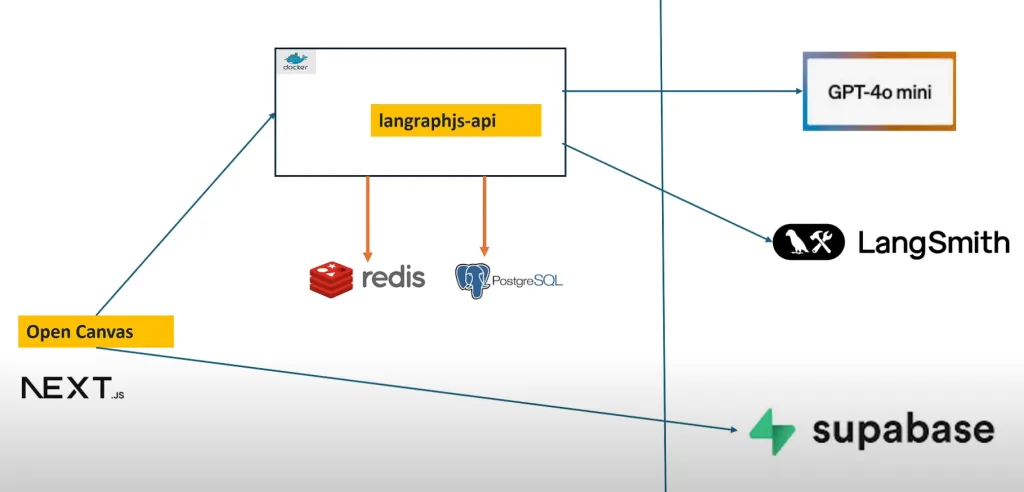
Open Canvas-本地使用 OpenAI Canvas功能
最近 OpenAI 推出了 Canvas ,開始流行在 ChatGPT 上頭寫程式、寫郵件等等,馬上就有人推出本地端一樣的服務 Open Canvas ,解放了你只能在 OpenAI 上使用的困境,除了 Git 以外,也馬上有了 docker 版本,可以快速體驗

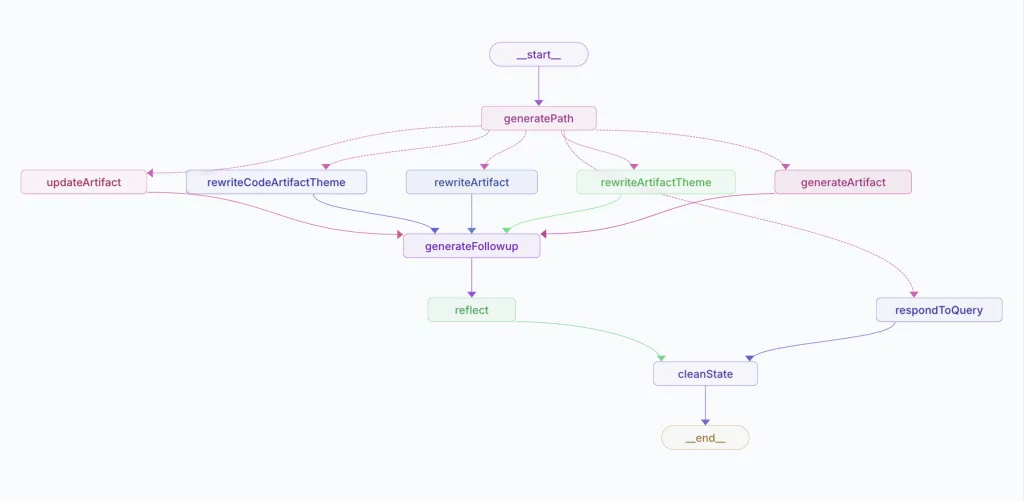

最近 OpenAI 推出了 Canvas ,開始流行在 ChatGPT 上頭寫程式、寫郵件等等,馬上就有人推出本地端一樣的服務 Open Canvas ,解放了你只能在 OpenAI 上使用的困境,除了 Git 以外,也馬上有了 docker 版本,可以快速體驗


可以中英文混合,笑聲,停頓的好用的語音生成模型
ChatTTS online DEMO https://chattts.com/#Demo
增強後好看又好用的 ChatTTS 外框 ChatTTS-Forge https://huggingface.co/spaces/lenML/ChatTTS-Forge
ChatTTS 官方說明 https://github.com/2noise/ChatTTS/blob/main/docs/cn/README.md
整合各種超強的 ChatTTS應用 https://github.com/libukai/Awesome-ChatTTS
ChatTTS 跟 Ollama 的整合 Demo https://github.com/melodylife/ollama-chat
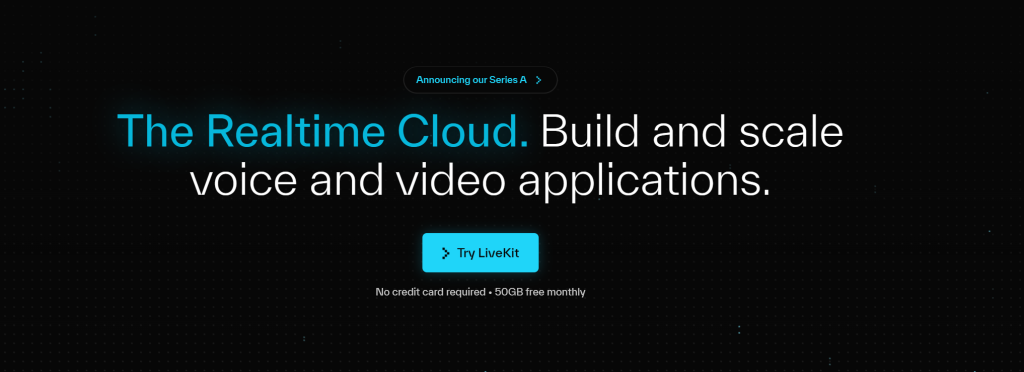
公開如何使用 OpenAI 配合 LiveKit 來實現會多國語言的小姐姐,可以即時回答您的問題,這個跟 Twilio 一樣的簡單和易用

利用 google 帳號登入 LiveKit Login 命名一個 project

並且到專案中的 settings -> KEYS ,取得 API KEY

pip install livekit-agents livekit-plugins-openai livekit-plugins-silero python-dotenv
LIVEKIT_URL="" LIVEKIT_API_KEY="" LIVEKIT_API_SECRET="" OPENAI_API_KEY=""
import asyncio
from dotenv import load_dotenv
from livekit.agents import AutoSubscribe, JobContext,WorkerOptions, cli, llm
from livekit.agents.voice_assistant import VoiceAssistant
from livekit.plugins import openai, silero
load_dotenv()
async def entry(ctx: JobContext):
chat_ctx = llm.ChatContext().append(
role="system",
text=("你是專業的助理,回答時候用專業的語氣回應。")
)
await ctx.connect(auto_subscribe=AutoSubscribe.AUDIO_ONLY)
asssitant = VoiceAssistant(
vad=silero.VAD.load(),
stt=openai.STT(),
tts=openai.TTS(voice="nova"),
llm=openai.LLM(model="gpt-4o-mini"),
chat_ctx=chat_ctx
)
asssitant.start(ctx.room)
await asyncio.sleep(1)
await asssitant.say("你好,第一次見面,很高興認識你",allow_interruptions=True)
if __name__ == "__main__":
cli.run_app(WorkerOptions(entrypoint_fnc=entry))道專案中,可以看到 Get started 中有支援各種的平台的程式碼以及 server 可以使用

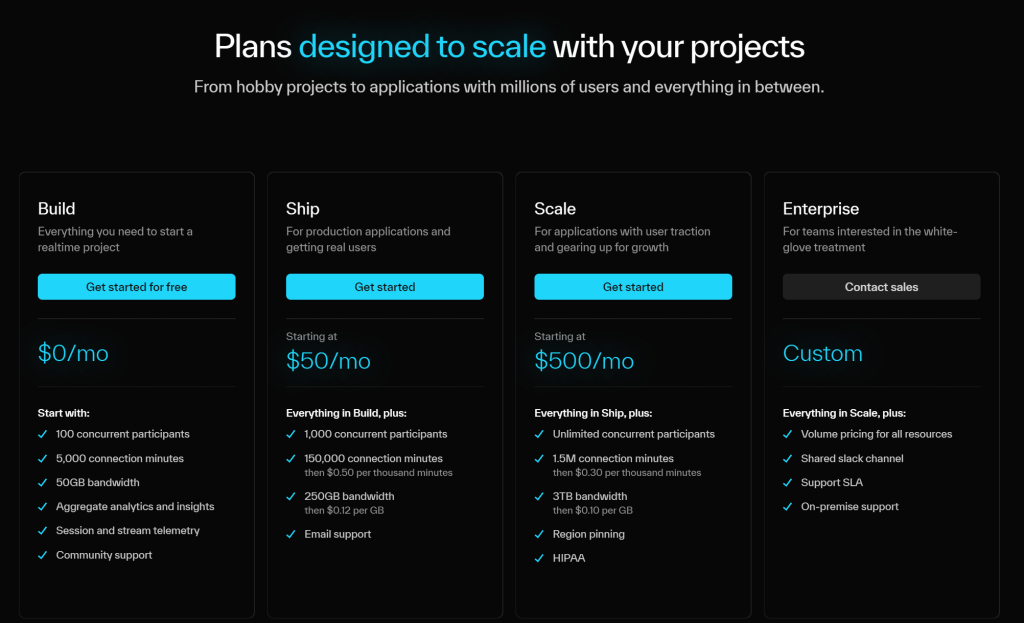
https://github.com/livekit/agents
GraphRAG圖像檢索增強生成(Graph Retrieval-Augmented Generation,GraphRAG)超好用,但也超級貴,超級花錢,想要省錢的話,就要用本地端的服務如(Ollama),要用的話,可以按照下面的步驟處理,前提是你已經可以使用 OpenAI 版本的 GraphRAG 了,本篇是要把 OpenAI 改成 Ollama
要先設定好 GraphRAG
下載以及安裝好 Ollama
pip install ollama
把舊的 yaml 檔案改成 ollama 的設定檔,新的設定檔案如下
encoding_model: cl100k_base
skip_workflows: []
llm:
api_key: ${GRAPHRAG_API_KEY}
type: openai_chat # or azure_openai_chat
# model: gpt-4o-mini
model_supports_json: true # recommended if this is available for your model.
# max_tokens: 4000
# request_timeout: 180.0
# api_base: https://<instance>.openai.azure.com
# api_version: 2024-02-15-preview
# organization: <organization_id>
# deployment_name: <azure_model_deployment_name>
# tokens_per_minute: 150_000 # set a leaky bucket throttle
# requests_per_minute: 10_000 # set a leaky bucket throttle
# max_retries: 10
# max_retry_wait: 10.0
# sleep_on_rate_limit_recommendation: true # whether to sleep when azure suggests wait-times
# concurrent_requests: 25 # the number of parallel inflight requests that may be made
# ollama api_base
api_base: http://localhost:11434/v1
model: llama3
parallelization:
stagger: 0.3
# num_threads: 50 # the number of threads to use for parallel processing
async_mode: threaded # or asyncio
embeddings:
## parallelization: override the global parallelization settings for embeddings
async_mode: threaded # or asyncio
llm:
api_key: ${GRAPHRAG_API_KEY}
type: openai_embedding # or azure_openai_embedding
# model: text-embedding-3-small
# ollama
model: nomic-embed-text
api_base: http://localhost:11434/api
# api_base: https://<instance>.openai.azure.com
# api_version: 2024-02-15-preview
# organization: <organization_id>
# deployment_name: <azure_model_deployment_name>
# tokens_per_minute: 150_000 # set a leaky bucket throttle
# requests_per_minute: 10_000 # set a leaky bucket throttle
# max_retries: 10
# max_retry_wait: 10.0
# sleep_on_rate_limit_recommendation: true # whether to sleep when azure suggests wait-times
# concurrent_requests: 25 # the number of parallel inflight requests that may be made
# batch_size: 16 # the number of documents to send in a single request
# batch_max_tokens: 8191 # the maximum number of tokens to send in a single request
# target: required # or optional
chunks:
size: 300
overlap: 100
group_by_columns: [id] # by default, we don't allow chunks to cross documents
input:
type: file # or blob
file_type: text # or csv
base_dir: "input"
file_encoding: utf-8
file_pattern: ".*\\.txt$"
cache:
type: file # or blob
base_dir: "cache"
# connection_string: <azure_blob_storage_connection_string>
# container_name: <azure_blob_storage_container_name>
storage:
type: file # or blob
base_dir: "output/${timestamp}/artifacts"
# connection_string: <azure_blob_storage_connection_string>
# container_name: <azure_blob_storage_container_name>
reporting:
type: file # or console, blob
base_dir: "output/${timestamp}/reports"
# connection_string: <azure_blob_storage_connection_string>
# container_name: <azure_blob_storage_container_name>
entity_extraction:
## llm: override the global llm settings for this task
## parallelization: override the global parallelization settings for this task
## async_mode: override the global async_mode settings for this task
prompt: "prompts/entity_extraction.txt"
entity_types: [organization,person,geo,event]
max_gleanings: 0
summarize_descriptions:
## llm: override the global llm settings for this task
## parallelization: override the global parallelization settings for this task
## async_mode: override the global async_mode settings for this task
prompt: "prompts/summarize_descriptions.txt"
max_length: 500
claim_extraction:
## llm: override the global llm settings for this task
## parallelization: override the global parallelization settings for this task
## async_mode: override the global async_mode settings for this task
# enabled: true
prompt: "prompts/claim_extraction.txt"
description: "Any claims or facts that could be relevant to information discovery."
max_gleanings: 0
community_report:
## llm: override the global llm settings for this task
## parallelization: override the global parallelization settings for this task
## async_mode: override the global async_mode settings for this task
prompt: "prompts/community_report.txt"
max_length: 2000
max_input_length: 8000
cluster_graph:
max_cluster_size: 10
embed_graph:
enabled: true # if true, will generate node2vec embeddings for nodes
# num_walks: 10
# walk_length: 40
# window_size: 2
# iterations: 3
# random_seed: 597832
umap:
enabled: true # if true, will generate UMAP embeddings for nodes
snapshots:
graphml: true
raw_entities: true
top_level_nodes: true
local_search:
# text_unit_prop: 0.5
# community_prop: 0.1
# conversation_history_max_turns: 5
# top_k_mapped_entities: 10
# top_k_relationships: 10
# max_tokens: 12000
global_search:
# max_tokens: 12000
# data_max_tokens: 12000
# map_max_tokens: 1000
# reduce_max_tokens: 2000
# concurrency: 32
其中修改 llm 區塊
修改 model: llama3
加入 api_base: http://localhost:11434/v1
修改 embeddings 區塊
model: nomic-embed-text
api_base: http://localhost:11434/api
除了設定好 setting.yaml 以外,程式碼也要修改成可以支持 ollama 的程式碼,有兩處要改,可以用以下現成的程式碼
加入 ollama setting 區塊
# Copyright (c) 2024 Microsoft Corporation.
# Licensed under the MIT License
"""The EmbeddingsLLM class."""
from typing_extensions import Unpack
from graphrag.llm.base import BaseLLM
from graphrag.llm.types import (
EmbeddingInput,
EmbeddingOutput,
LLMInput,
)
import ollama
from .openai_configuration import OpenAIConfiguration
from .types import OpenAIClientTypes
class OpenAIEmbeddingsLLM(BaseLLM[EmbeddingInput, EmbeddingOutput]):
"""A text-embedding generator LLM."""
_client: OpenAIClientTypes
_configuration: OpenAIConfiguration
def __init__(self, client: OpenAIClientTypes, configuration: OpenAIConfiguration):
self.client = client
self.configuration = configuration
async def _execute_llm(
self, input: EmbeddingInput, **kwargs: Unpack[LLMInput]
) -> EmbeddingOutput | None:
args = {
"model": self.configuration.model,
**(kwargs.get("model_parameters") or {}),
}
# openai setting
# embedding = await self.client.embeddings.create(
# input=input,
# **args,
#)
#return [d.embedding for d in embedding.data]
# ollama setting
embedding_list=[]
for inp in input:
embedding = ollama.embeddings(model='qwen:7b', prompt=inp) #如果要改模型, 模型的名字要換掉
embedding_list.append(embedding['embedding'])
return embedding_list
加入 ollama setting 區塊,並且關閉 openai setting 區塊即可
# Copyright (c) 2024 Microsoft Corporation.
# Licensed under the MIT License
"""OpenAI Embedding model implementation."""
import asyncio
from collections.abc import Callable
from typing import Any
import numpy as np
import tiktoken
from tenacity import (
AsyncRetrying,
RetryError,
Retrying,
retry_if_exception_type,
stop_after_attempt,
wait_exponential_jitter,
)
from graphrag.query.llm.base import BaseTextEmbedding
from graphrag.query.llm.oai.base import OpenAILLMImpl
from graphrag.query.llm.oai.typing import (
OPENAI_RETRY_ERROR_TYPES,
OpenaiApiType,
)
from graphrag.query.llm.text_utils import chunk_text
from graphrag.query.progress import StatusReporter
import ollama
class OpenAIEmbedding(BaseTextEmbedding, OpenAILLMImpl):
"""Wrapper for OpenAI Embedding models."""
def __init__(
self,
api_key: str | None = None,
azure_ad_token_provider: Callable | None = None,
model: str = "text-embedding-3-small",
deployment_name: str | None = None,
api_base: str | None = None,
api_version: str | None = None,
api_type: OpenaiApiType = OpenaiApiType.OpenAI,
organization: str | None = None,
encoding_name: str = "cl100k_base",
max_tokens: int = 8191,
max_retries: int = 10,
request_timeout: float = 180.0,
retry_error_types: tuple[type[BaseException]] = OPENAI_RETRY_ERROR_TYPES, # type: ignore
reporter: StatusReporter | None = None,
):
OpenAILLMImpl.__init__(
self=self,
api_key=api_key,
azure_ad_token_provider=azure_ad_token_provider,
deployment_name=deployment_name,
api_base=api_base,
api_version=api_version,
api_type=api_type, # type: ignore
organization=organization,
max_retries=max_retries,
request_timeout=request_timeout,
reporter=reporter,
)
self.model = model
self.encoding_name = encoding_name
self.max_tokens = max_tokens
self.token_encoder = tiktoken.get_encoding(self.encoding_name)
self.retry_error_types = retry_error_types
def embed(self, text: str, **kwargs: Any) -> list[float]:
"""
Embed text using OpenAI Embedding's sync function.
For text longer than max_tokens, chunk texts into max_tokens, embed each chunk, then combine using weighted average.
Please refer to: https://github.com/openai/openai-cookbook/blob/main/examples/Embedding_long_inputs.ipynb
"""
token_chunks = chunk_text(
text=text, token_encoder=self.token_encoder, max_tokens=self.max_tokens
)
chunk_embeddings = []
chunk_lens = []
for chunk in token_chunks:
try:
# openai setting
#embedding, chunk_len = self._embed_with_retry(chunk, **kwargs)
#chunk_embeddings.append(embedding)
#chunk_lens.append(chunk_len)
# ollama setting
embedding = ollama.embeddings(model="nomic-embed-text", prompt=chunk)['embedding'] #如果要替換嵌入模型, 請修改此處的模型名稱
chunk_lens.append(chunk)
chunk_embeddings.append(embedding)
chunk_lens.append(chunk_lens)
# TODO: catch a more specific exception
except Exception as e: # noqa BLE001
self._reporter.error(
message="Error embedding chunk",
details={self.__class__.__name__: str(e)},
)
continue
#chunk_embeddings = np.average(chunk_embeddings, axis=0, weights=chunk_lens)
#chunk_embeddings = chunk_embeddings / np.linalg.norm(chunk_embeddings)
return chunk_embeddings.tolist()
async def aembed(self, text: str, **kwargs: Any) -> list[float]:
"""
Embed text using OpenAI Embedding's async function.
For text longer than max_tokens, chunk texts into max_tokens, embed each chunk, then combine using weighted average.
"""
token_chunks = chunk_text(
text=text, token_encoder=self.token_encoder, max_tokens=self.max_tokens
)
chunk_embeddings = []
chunk_lens = []
embedding_results = await asyncio.gather(*[
self._aembed_with_retry(chunk, **kwargs) for chunk in token_chunks
])
embedding_results = [result for result in embedding_results if result[0]]
chunk_embeddings = [result[0] for result in embedding_results]
chunk_lens = [result[1] for result in embedding_results]
chunk_embeddings = np.average(chunk_embeddings, axis=0, weights=chunk_lens) # type: ignore
chunk_embeddings = chunk_embeddings / np.linalg.norm(chunk_embeddings)
return chunk_embeddings.tolist()
def _embed_with_retry(
self, text: str | tuple, **kwargs: Any
) -> tuple[list[float], int]:
try:
retryer = Retrying(
stop=stop_after_attempt(self.max_retries),
wait=wait_exponential_jitter(max=10),
reraise=True,
retry=retry_if_exception_type(self.retry_error_types),
)
for attempt in retryer:
with attempt:
embedding = (
self.sync_client.embeddings.create( # type: ignore
input=text,
model=self.model,
**kwargs, # type: ignore
)
.data[0]
.embedding
or []
)
return (embedding, len(text))
except RetryError as e:
self._reporter.error(
message="Error at embed_with_retry()",
details={self.__class__.__name__: str(e)},
)
return ([], 0)
else:
# TODO: why not just throw in this case?
return ([], 0)
async def _aembed_with_retry(
self, text: str | tuple, **kwargs: Any
) -> tuple[list[float], int]:
try:
retryer = AsyncRetrying(
stop=stop_after_attempt(self.max_retries),
wait=wait_exponential_jitter(max=10),
reraise=True,
retry=retry_if_exception_type(self.retry_error_types),
)
async for attempt in retryer:
with attempt:
embedding = (
await self.async_client.embeddings.create( # type: ignore
input=text,
model=self.model,
**kwargs, # type: ignore
)
).data[0].embedding or []
return (embedding, len(text))
except RetryError as e:
self._reporter.error(
message="Error at embed_with_retry()",
details={self.__class__.__name__: str(e)},
)
return ([], 0)
else:
# TODO: why not just throw in this case?
return ([], 0)
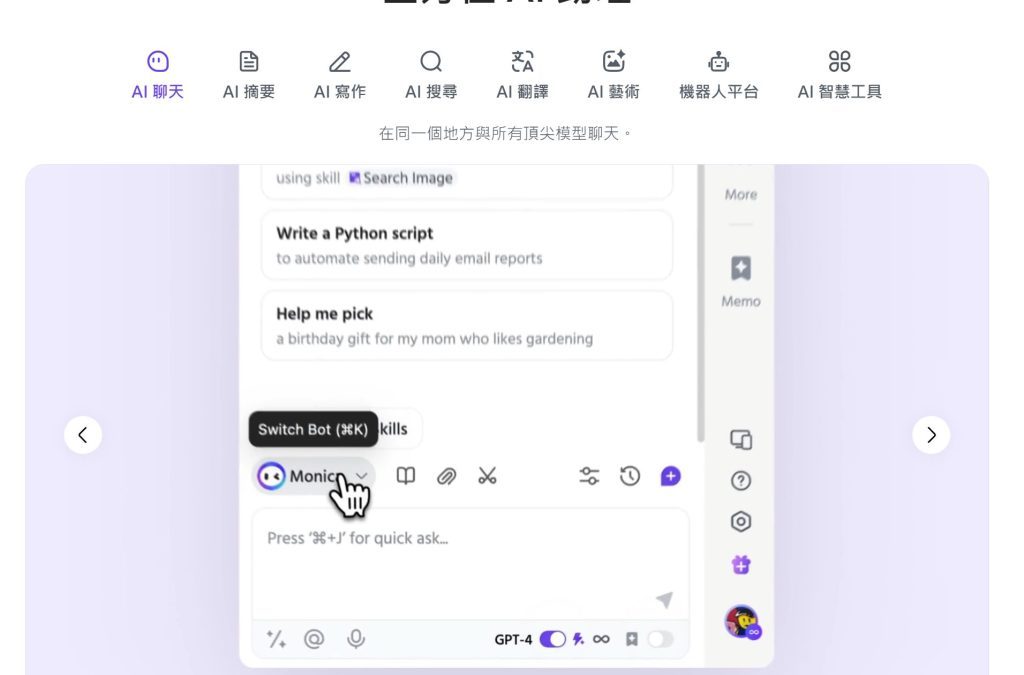
Monica AI 最早是一個 Chrome 瀏覽器的外掛,只要安裝好後按下 Cmd+M 或 Ctrl+M,就可以開始與她聊天。或讓 Monica 幫助您組織和插入文本到任何網頁上。後台可以接上各家的AI模型,並且從超過 80 個模板中選擇一個模板,可以快速生成營銷文案。選擇網頁上的文本,讓 Monica 為您解釋、翻譯、改寫文章。
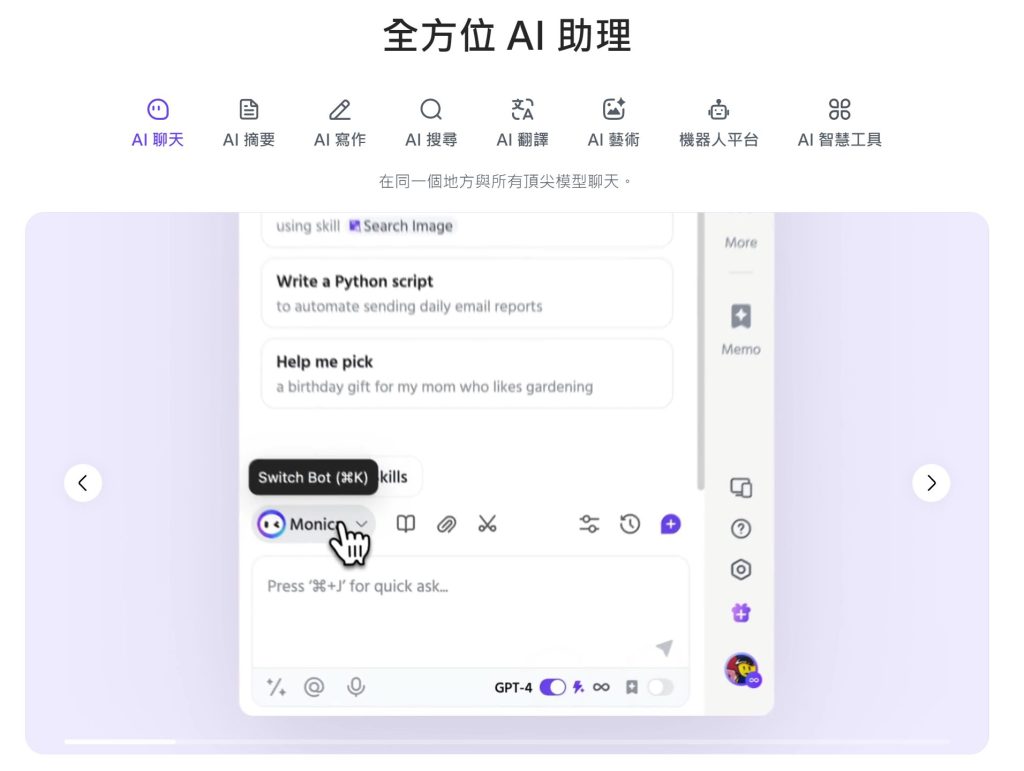
官網:
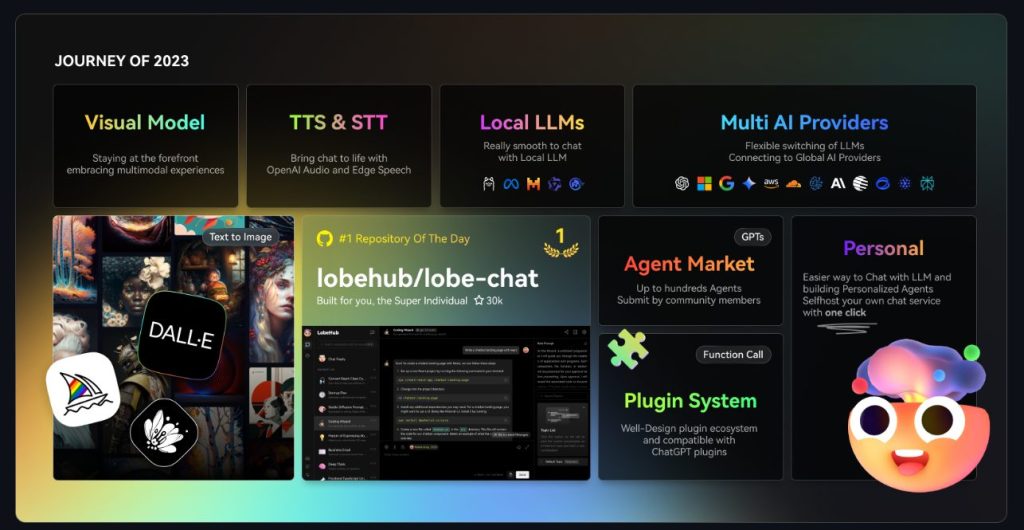
一個可以支援本地模型(ollama),支援使用者拖拉圖片到對話框、文生圖、STT、TTS、插件設計(Plugin)、自建GPTs、資料庫的強大的 Web Chat UI

https://lobehub.com/zh-TW/docs/self-hosting/start
git clone https://github.com/lobehub/lobe-chat.git cd lobe-chat pnpm install pnpm run dev
docker run -d -p 3210:3210 \ -e OPENAI_API_KEY=sk-xxxx \ -e ACCESS_CODE=lobe66 \ --name lobe-chat \ lobehub/lobe-chat
近期留言